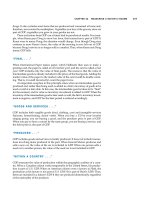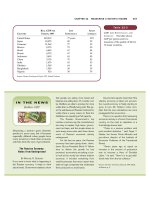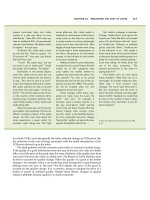Ten Principles of Economics - Part 49
Bạn đang xem bản rút gọn của tài liệu. Xem và tải ngay bản đầy đủ của tài liệu tại đây (261.18 KB, 10 trang )
CHAPTER 22 MEASURING A NATION’S INCOME 497
drugs. It also excludes most items that are produced and consumed at home and,
therefore, never enter the marketplace. Vegetables you buy at the grocery store are
part of GDP; vegetables you grow in your garden are not.
These exclusions from GDP can at times lead to paradoxical results. For exam-
ple, when Karen pays Doug to mow her lawn, that transaction is part of GDP. If
Karen were to marry Doug, the situation would change. Even though Doug may
continue to mow Karen’s lawn, the value of the mowing is now left out of GDP
because Doug’s service is no longer sold in a market. Thus, when Karen and Doug
marry, GDP falls.
“FINAL . . .”
When International Paper makes paper, which Hallmark then uses to make a
greeting card, the paper is called an intermediate good, and the card is called a final
good. GDP includes only the value of final goods. The reason is that the value of
intermediate goods is already included in the prices of the final goods. Adding the
market value of the paper to the market value of the card would be double count-
ing. That is, it would (incorrectly) count the paper twice.
An important exception to this principle arises when an intermediate good is
produced and, rather than being used, is added to a firm’s inventory of goods to be
used or sold at a later date. In this case, the intermediate good is taken to be “final”
for the moment, and its value as inventory investment is added to GDP. When the
inventory of the intermediate good is later used or sold, the firm’s inventory invest-
ment is negative, and GDP for the later period is reduced accordingly.
“GOODS AND SERVICES . . .”
GDP includes both tangible goods (food, clothing, cars) and intangible services
(haircuts, housecleaning, doctor visits). When you buy a CD by your favorite
singing group, you are buying a good, and the purchase price is part of GDP.
When you pay to hear a concert by the same group, you are buying a service, and
the ticket price is also part of GDP.
“PRODUCED . . .”
GDP includes goods and services currently produced. It does not include transac-
tions involving items produced in the past. When General Motors produces and
sells a new car, the value of the car is included in GDP. When one person sells a
used car to another person, the value of the used car is not included in GDP.
“WITHIN A COUNTRY . . .”
GDP measures the value of production within the geographic confines of a coun-
try. When a Canadian citizen works temporarily in the United States, his produc-
tion is part of U.S. GDP. When an American citizen owns a factory in Haiti, the
production at his factory is not part of U.S. GDP. (It is part of Haiti’s GDP.) Thus,
items are included in a nation’s GDP if they are produced domestically, regardless
of the nationality of the producer.
498 PART EIGHT THE DATA OF MACROECONOMICS
“. . . IN A GIVEN PERIOD OF TIME.”
GDP measures the value of production that takes place within a specific interval of
time. Usually that interval is a year or a quarter (three months). GDP measures the
economy’s flow of income and expenditure during that interval.
When the government reports the GDP for a quarter, it usually presents
GDP “at an annual rate.” This means that the figure reported for quarterly GDP is
the amount of income and expenditure during the quarter multiplied by 4. The
government uses this convention so that quarterly and annual figures on GDP can
be compared more easily.
In addition, when the government reports quarterly GDP, it presents the data
after they have been modified by a statistical procedure called seasonal adjustment.
The unadjusted data show clearly that the economy produces more goods and
services during some times of year than during others. (As you might guess,
December’s Christmas shopping season is a high point.) When monitoring the
When the U.S. Department
of Commerce computes the
nation’s GDP every three
months, it also computes vari-
ous other measures of income
to get a more complete picture
of what’s happening in the econ-
omy. These other measures dif-
fer from GDP by excluding or
including certain categories of
income. What follows is a brief
description of five of these
income measures, ordered from
largest to smallest.
◆ Gross national product (GNP) is the total income
earned by a nation’s permanent residents (called
nationals). It differs from GDP by including income that
our citizens earn abroad and excluding income that for-
eigners earn here. For example, when a Canadian citi-
zen works temporarily in the United States, his
production is part of U.S. GDP, but it is not part of U.S.
GNP. (It is par t of Canada’s GNP.) For most countries,
including the United States, domestic residents are
responsible for most domestic production, so GDP and
GNP are quite close.
◆ Net national product (NNP) is the total income of a
nation’s residents (GNP) minus losses from depreciation.
Depreciation is the wear and tear on the economy’s
stock of equipment and structures, such as trucks rust-
ing and lightbulbs burning out. In the national income
accounts prepared by the Department of Commerce,
depreciation is called the “consumption of fixed capital.”
◆ National income is the total income earned by a
nation’s residents in the production of goods and ser-
vices. It differs from net national product by excluding
indirect business taxes (such as sales taxes) and
including business subsidies. NNP and national income
also differ because of a “statistical discrepancy” that
arises from problems in data collection.
◆ Personal income is the income that households and
noncorporate businesses receive. Unlike national
income, it excludes retained earnings, which is income
that corporations have earned but have not paid out to
their owners. It also subtracts corporate income taxes
and contributions for social insurance (mostly Social
Security taxes). In addition, personal income includes
the interest income that households receive from their
holdings of government debt and the income that
households receive from government transfer pro-
grams, such as welfare and Social Security.
◆ Disposable personal income is the income that house-
holds and noncorporate businesses have left after sat-
isfying all their obligations to the government. It equals
personal income minus personal taxes and certain non-
tax payments (such as traffic tickets).
Although the various measures of income differ in detail,
they almost always tell the same story about economic con-
ditions. When GDP is growing rapidly, these other measures
of income are usually growing rapidly. And when GDP is
falling, these other measures are usually falling as well. For
monitoring fluctuations in the overall economy, it does not
matter much which measure of income we use.
FYI
Other Measures
of Income
CHAPTER 22 MEASURING A NATION’S INCOME 499
condition of the economy, economists and policymakers often want to look
beyond these regular seasonal changes. Therefore, government statisticians adjust
the quarterly data to take out the seasonal cycle. The GDP data reported in the
news are always seasonally adjusted.
Now let’s repeat the definition of GDP:
◆ Gross domestic product (GDP) is the market value of all final goods and
services produced within a country in a given period of time.
It should be apparent that GDP is a sophisticated measure of the value of economic
activity. In advanced courses in macroeconomics, you will learn more of the sub-
tleties that arise in its calculation. But even now you can see that each phrase in
this definition is packed with meaning.
QUICK QUIZ: Which contributes more to GDP—the production of a pound
of hamburger or the production of a pound of caviar? Why?
THE COMPONENTS OF GDP
Spending in the economy takes many forms. At any moment, the Smith family
may be having lunch at Burger King; General Motors may be building a car facto-
ry; the Navy may be procuring a submarine; and British Airways may be buying
an airplane from Boeing. GDP includes all of these various forms of spending on
domestically produced goods and services.
To understand how the economy is using its scarce resources, economists are
often interested in studying the composition of GDP among various types of spend-
ing. To do this, GDP (which we denote as Y) is divided into four components: con-
sumption (C), investment (I), government purchases (G), and net exports (NX):
Y ϭ C ϩ I ϩ G ϩ NX.
This equation is an identity—an equation that must be true by the way the vari-
ables in the equation are defined. In this case, because each dollar of expenditure
included in GDP is placed into one of the four components of GDP, the total of the
four components must be equal to GDP.
We have just seen an example of each component. Consumption is spending
by households on goods and services, such as the Smiths’ lunch at Burger King.
Investment is the purchase of capital equipment, inventories, and structures, such
as the General Motors factory. Investment also includes expenditure on new hous-
ing. (By convention, expenditure on new housing is the one form of household
spending categorized as investment rather than consumption.) Government pur-
chases include spending on goods and services by local, state, and federal govern-
ments, such as the Navy’s purchase of a submarine. Net exports equal the
purchases of domestically produced goods by foreigners (exports) minus the
domestic purchases of foreign goods (imports). A domestic firm’s sale to a buyer in
another country, such as the Boeing sale to British Airways, increases net exports.
The “net” in “net exports” refers to the fact that imports are subtracted from
exports. This subtraction is made because imports of goods and services are
consumption
spending by households on goods
and services, with the exception of
purchases of new housing
investment
spending on capital equipment,
inventories, and structures,
including household purchases of
new housing
government purchases
spending on goods and services by
local, state, and federal governments
net exports
spending on domestically produced
goods by foreigners (exports) minus
spending on foreign goods by
domestic residents (imports)
500 PART EIGHT THE DATA OF MACROECONOMICS
included in other components of GDP. For example, suppose that a household
buys a $30,000 car from Volvo, the Swedish carmaker. That transaction increases
consumption by $30,000 because car purchases are part of consumer spending. It
also reduces net exports by $30,000 because the car is an import. In other words,
net exports include goods and services produced abroad (with a minus sign)
because these goods and services are included in consumption, investment, and
government purchases (with a plus sign). Thus, when a domestic household, firm,
or government buys a good or service from abroad, the purchase reduces net
exports—but because it also raises consumption, investment, or government pur-
chases, it does not affect GDP.
The meaning of “government purchases” also requires a bit of clarification.
When the government pays the salary of an Army general, that salary is part of
government purchases. But what happens when the government pays a Social
Security benefit to one of the elderly? Such government spending is called a trans-
fer payment because it is not made in exchange for a currently produced good or
service. From a macroeconomic standpoint, transfer payments are like a tax rebate.
Like taxes, transfer payments alter household income, but they do not reflect the
economy’s production. Because GDP is intended to measure income from (and
expenditure on) the production of goods and services, transfer payments are not
counted as part of government purchases.
Table 22-1 shows the composition of U.S. GDP in 1998. In this year, the GDP of
the United States was about $8.5 trillion. If we divide this number by the 1998 U.S.
population of 270 million, we find that GDP per person—the amount of expendi-
ture for the average American—was $31,522. Consumption made up about two-
thirds of GDP, or $21,511 per person. Investment was $5,063 per person.
Government purchases were $5,507 per person. Net exports were –$559 per per-
son. This number is negative because Americans earned less from selling to for-
eigners than they spent on foreign goods.
QUICK QUIZ: List the four components of expenditure. Which is the largest?
REAL VERSUS NOMINAL GDP
As we have seen, GDP measures the total spending on goods and services in all
markets in the economy. If total spending rises from one year to the next, one of
two things must be true: (1) the economy is producing a larger output of goods
Table 22-1
GDP
AND
I
TS
C
OMPONENTS
.
This table shows total GDP for
the U.S. economy in 1998 and the
breakdown of GDP among its
four components. When reading
this table, recall the identity
Y ϭ C ϩ I ϩ G ϩ NX.
T
OTAL
P
ERCENT
(
IN BILLIONS
)P
ER
P
ERSON OF
T
OTAL
Gross domestic product, Y $8,511 $31,522 100%
Consumption, C 5,808 21,511 68
Investment, I 1,367 5,063 16
Government purchases, G 1,487 5,507 18
Net exports, NX Ϫ151 Ϫ559 Ϫ2
S
OURCE
: U.S. Department of Commerce.
CHAPTER 22 MEASURING A NATION’S INCOME 501
and services, or (2) goods and services are being sold at higher prices. When
studying changes in the economy over time, economists want to separate these
two effects. In particular, they want a measure of the total quantity of goods and
services the economy is producing that is not affected by changes in the prices of
those goods and services.
To do this, economists use a measure called real GDP. Real GDP answers a
hypothetical question: What would be the value of the goods and services pro-
duced this year if we valued these goods and services at the prices that prevailed
in some specific year in the past? By evaluating current production using prices
that are fixed at past levels, real GDP shows how the economy’s overall produc-
tion of goods and services changes over time.
To see more precisely how real GDP is constructed, let’s consider an example.
A NUMERICAL EXAMPLE
Table 22-2 shows some data for an economy that produces only two goods—hot
dogs and hamburgers. The table shows the quantities of the two goods produced
and their prices in the years 2001, 2002, and 2003.
Table 22-2
P
RICES AND
Q
UANTITIES
Y
EAR
P
RICEOF
H
OT
D
OGS
Q
UANTITY OF
H
OT
D
OGS
P
RICEOF
H
AMBURGERS
Q
UANTITY OF
H
AMBURGERS
2001 $1 100 $2 50
2002 2 150 3 100
2003 3 200 4 150
Y
EAR
C
ALCULATING
N
OMINAL
GDP
2001 ($1 per hot dog ϫ 100 hot dogs) ϩ ($2 per hamburger ϫ 50 hamburgers) ϭ $200
2002 ($2 per hot dog ϫ 150 hot dogs) ϩ ($3 per hamburger ϫ 100 hamburgers) ϭ $600
2003 ($3 per hot dog ϫ 200 hot dogs) ϩ ($4 per hamburger ϫ 150 hamburgers) ϭ $1,200
Y
EAR
C
ALCULATING
R
EAL
GDP (
BASEYEAR
2001)
2001 ($1 per hot dog ϫ 100 hot dogs) ϩ ($2 per hamburger ϫ 50 hamburgers) ϭ $200
2002 ($1 per hot dog ϫ 150 hot dogs) ϩ ($2 per hamburger ϫ 100 hamburgers) ϭ $350
2003 ($1 per hot dog ϫ 200 hot dogs) ϩ ($2 per hamburger ϫ 150 hamburgers) ϭ $500
Y
EAR
C
ALCULATING THE
GDP D
EFLATOR
2001 ($200/$200) ϫ 100 ϭ 100
2002 ($600/$350) ϫ 100 ϭ 171
2003 ($1,200/$500) ϫ 100 ϭ 240
R
EAL AND
N
OMINAL
GDP. This table shows how to calculate real GDP, nominal GDP,
and the GDP deflator for a hypothetical economy that produces only hot dogs and
hamburgers.









